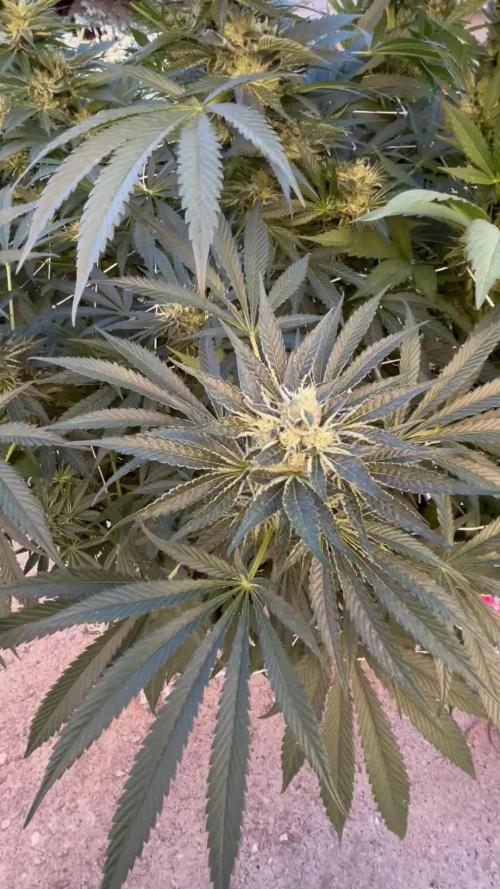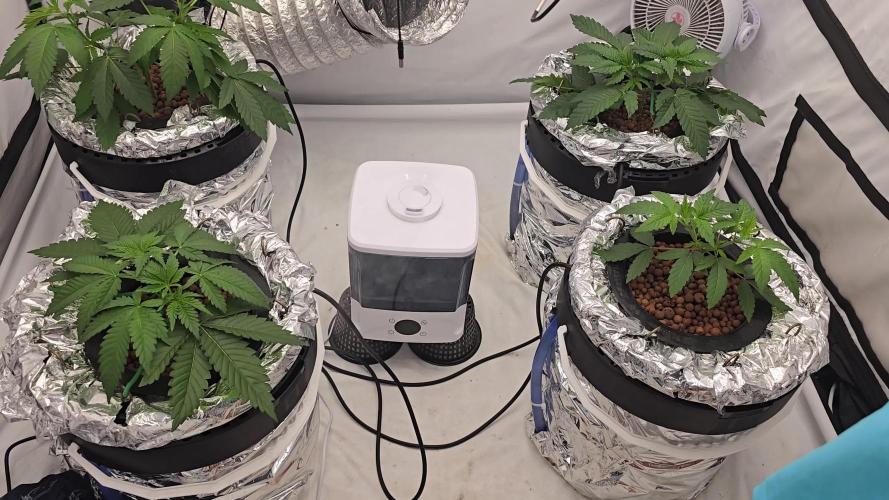By continuing to use the website or clicking Accept you consent to our cookies and personal data policy and confirm that you are at least 18 year old. For details please see Privacy Policy and Terms
Accept
Likes
Comments
Share


@Northern_Ent
Follow
Sep 13: nearing the finish line. Doing a chemical flush this year cuz my buds lasy year often didn’t burn very well due to too much P. Using Final Flush from Grotek which uses citric acid as a chelating agent. Other flushes like Flawless Finish use EDTA which I’d rather avoid.
Sep 15: removed fan leaves that were shading buds.
Likes
4
Share


@pzwags420
Follow
Week 7 is going smoothly so far. The flooding issue has subsided and the clones seem to be really taking off now. I'm excited to get back from vacation and really see my girls and my reservoir conditions after a 2 week hiatus.
Likes
Comments
Share


@MrStarOn3
Follow
At the end of week 3 I topped one of the strawberry cough they are all looking good and starting to veg I’m all caught up with the grow diary’s and will add at the end of every week. I’m in Australia and did start a little late into the season but hope to get a decent grow in they will be at my brothers once transplanted and he has a few aswel that I will add into the grow log nothing but sun and water only use a little thrive that’s from Bunnings that I get from my pops shed. They will be in a nicer cleaner soil when transplanted into veggie beds and will have chicken poo as a nutrient source first time ever using chicken poo so see how it goes. Will keep the grow log updated and hopefully everything goes all well for the travel and transplant for the plants in the next few days
Likes
4
Share


@Mr_nugs_lover_David
Follow
Esta Do-si-Dos cookies de 00 seeds es excelente,súper rico aroma,cogollos tremendamente compactos y duros como piedras,pegajosos y resinosos,amo esta genetica la volvería a cultivar 100 veces mas 🤩 esta es la última semana que riego con bio bloom y top max,a partiré de hoy los riegos son de agua con el ph regulado como siempre pero sin añadir ningún nutriente por supuesto para poder hacer un correcto lavado de raíces para eliminar sales. En definitiva y desde mi punto de vista,gran genetica,vale la pena cultivar esta maravilla! 🇺🇸🍪
Likes
5
Share


@cookingwithninja
Follow
Plants are currently drying
2+ months later. And next project au79
Likes
20
Share


@AlexJekomust
Follow
Speedy Boom auto started flowering, is now 1 month old and has grown tremendously in width, stayed as small as I wanted, I started following the Advanced Nutrients Flowering Fertilizer Program
Likes
8
Share


@gothboiclique
Follow
Me costó adaptarme a la cantidad de agua que necesitaba, prácticamente 1.5 litros todos los días. Temperatura 23-25 centígrados, HR 45%.
Me pueden contactar por ig @federicocabreraf , por si quieren saber mas detalles o algún comentario que me quieran hacer, paz.
Likes
5
Share


@Stork
Follow
Day 23 Tue
PH 5.8
EC 0.5
DLI 18h
PPFD
Water 24c
Day 26 Sat
Refresh nuts
PH 5.8
EC 0.6
DLI 18h
PPFD
Water 24c
Processing
Likes
9
Share


@Kushizlez
Follow
Everything coming along nicely. I’ve discontinued all nutes but will give one more little top dressing to the cheese plant tomorrow then that’s it. Just straight stabilized RO water from here out. The slurricane is just packing on PM like crazy. The cheese has actually stopped the spread for the most part. At harvest I’m going to wash the shit out of the slurricane and cheese with some warm RO water and some h202 to get the majority of it dissolved. Other than that the quality of the slurricane is beyond ridiculous. It’s by far the stickiest strain to the touch in the tent. It’s probably winning for smell too. It’s straight gassy licorice pine. The pm susceptibility is a deal breaking drawback though.
The cheese is looking good and smells great. It almost smells like rotten milk. Some of the nugs are really filling out into these nice long chunky little things. The pistils are turning a light orange/pink color too. Unfortunately it’s not maturing at the same rate and will make everything in the tent go for another 1.5-2 weeks.
Garlics are looking better. The lanky pheno has filled out quite a bit more than expected and is super frosty with a great smell. It’s finally starting to purple up a bit. I think it will still be quite leafy around harvest but time will tell. Pheno 2 has better structure and density but lacks frost, smell and color. Not very impressed by it honestly.
The zkittlez is looking great and getting super frosty. Especially around the crowns of the top colas. Lowers look like shit though. Despite being somewhat leafy, the main branches look quite dense. It’s probably the shortest and bushiest plant in the garden. It’s yellowing out quite a bit now and will probably finish with the blackberries and slurricane.
The blackberries look amazing and smell even better. One of the phenos is a crazy producer and creates massive buds with musky berry terps. The other pheno is a beautiful purple strain that produces a crazy amount of frost and chunky golf ball nugs at the expense of large yield. It’s smell is very sweet and candy like and has been a very low feeding and maintenance plant.
Slurricane #4 looks great aside from its infection. It definitely wins for resin content and smell but looks like a low yielder.
Likes
8
Share


@ProKush27
Follow
Over the last week I’ve continued with defoliation process and I removed downer leaves that were not developing properly.
On day 78 I added support for aide branches on B and C.
I started flush of plant C on day 80, so we’ll see how she looks. I keep feeding other plants but I will be starting flush soon. 😎
Likes
6
Share


@ao_grows1978
Follow
The solo cup Afghani x Mac1 from DNA Junkies is coming to an end. These sticky buds are starting to fade and turning a blueish purple. The smell is strong. Very fruit forward with petrol. Still feeding off the last top dressing.
Likes
11
Share


@Skunkiest_bender39
Follow
Schade um die Schwestern… aber die Damen freuen sich sehr über den Platz bin gespannt wie es weiter geht. Habe noch ein Ventilator unterhalb der Pflanzen platziert. Sollte jetzt endlich auf Zielgerade gehen. Je nachdem was passiert, werden die Damen voraussichtlich in 3wochen geerntet!🐝
Likes
7
Share


@Adam22
Follow
Lefty was dropped during veg that explains why she looks a few days behind the other i damaged a high fan leaf in about week 5 of veg and now I know what effect it has so not to do it again! Started on pk13 two days ago just a video update for now 😋
Likes
32
Share


@Sejnik
Follow
3 dny po posledním tréninku (53 dní od vyklíčení) jsem změnil světelný cyklus na 12/12. Nastavil jsem SCROG síť do finální výšky a nyní zbývá jen čekat až holky vyrostou 🤩 snad se mi podaří vytvořit rovnoměrný baldachýn.
Blumat zavlažování funguje skvěle a rostliny jsou s ním velmi spokojené.
V substrátu se mi rozmnožili springtails. Beru to jako dobrou zprávu poukazující na dostatek organického materiálu kterým se živí. Ale i tak budu jejich počty hlídat a redukovat postřikem substrátu pomocí nimbového oleje (1 polévková lžíce na 1 litr vody + 3 kapky mycího prostředku na nádobí) vždy když mi přijdou jejich počty moc vysoké.
Processing
Likes
166
Share


@iMeus
Follow
~ Update ~
Hello my friends, welcome back to another weekly update. I have a few issues going on so I’ll put those below in the IPN. This has been a good week so far, the girls are very happy, except the bazar mazar… Other than that it’s exciting that I’m pretty much at the halfway point :) Anyways, enjoy the update and let me know what you think in the comments, I always appreciate feedback
~ Individual Progress Notes ~
[CBD]
Notes: This is the healthiest of the bunch, nice rich green leaves and fluffy buds. I’m surprised the this little mutant is doing so well. As I said in the vlog GCS got back to me last week, I’ll keep them up to date with my grow so they know what’s going on with this girl.
[Mazar]
Notes: Burn! I’m noticing a lot of small but noticeable spots, leaf chattering, and slight yellowing at the tip of the leaves. I feel like I should just avoid feeding this girl though I’m not sure if that will help the situation. If you guys can take a look at this girl I’d really appreciate it :)
Edit: I found out thanks to my friends here on GD that I burned my Bazar Mazar :( So time for water which I might only give her water and flower fuel then flush till harvest (might be my cleanest tasting and smelling afterwards). It's hard to feed 4 different metabolisms every watering, but hey I'm learning :)
[Super Silver Haze]
Notes: The beast of the grow! What a lovely plant. Even though this girl got really hungry and started cannibalizing the lower leaves her buds are massive! I’m impressed with the total growth of this beast. Honestly, I’m cheering this girl on, might be my favorite (don’t tell the others).
[White Widow]
Notes: More like purple widow, this dense girl is showing her dark side and I like it. I planned on the purpling, still surprising to see all this purple though. I like purple buds but I don’t want this (or any of the girls) getting shocked by the cold. Hoping the I can get a few more pieces of gear to help out the next grow.
~ Final Thoughts ~
What a week, some of the girls are rocking and the Mazar, not so much :) It’s a learning experience that will take some time for me to learn how to balance all (most) of the variables. Thank you guys so much for all the love and support, I always appreciate it :)
Happy holidays and good grow’n fam, much love
Meus <3
























